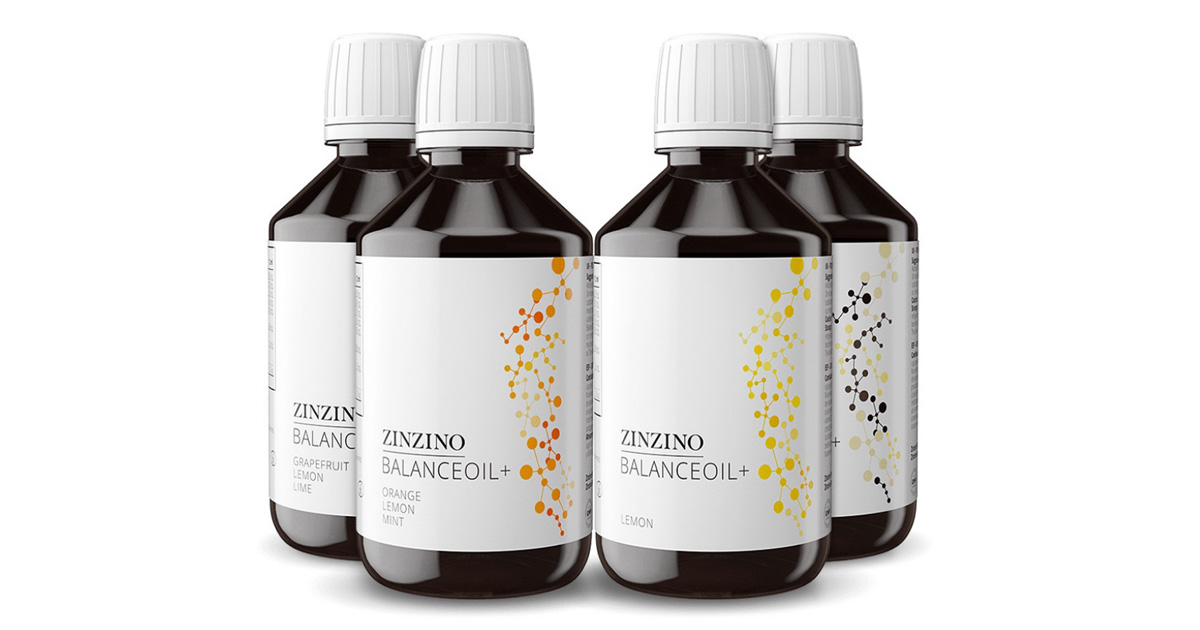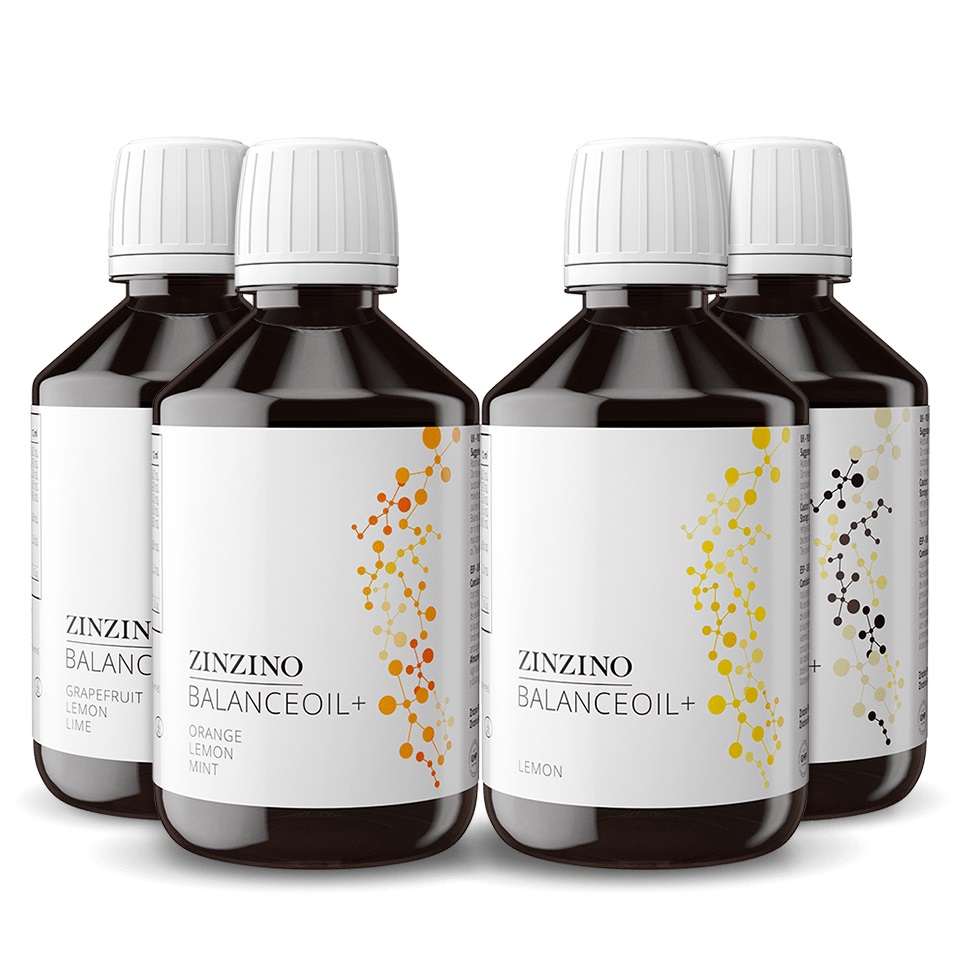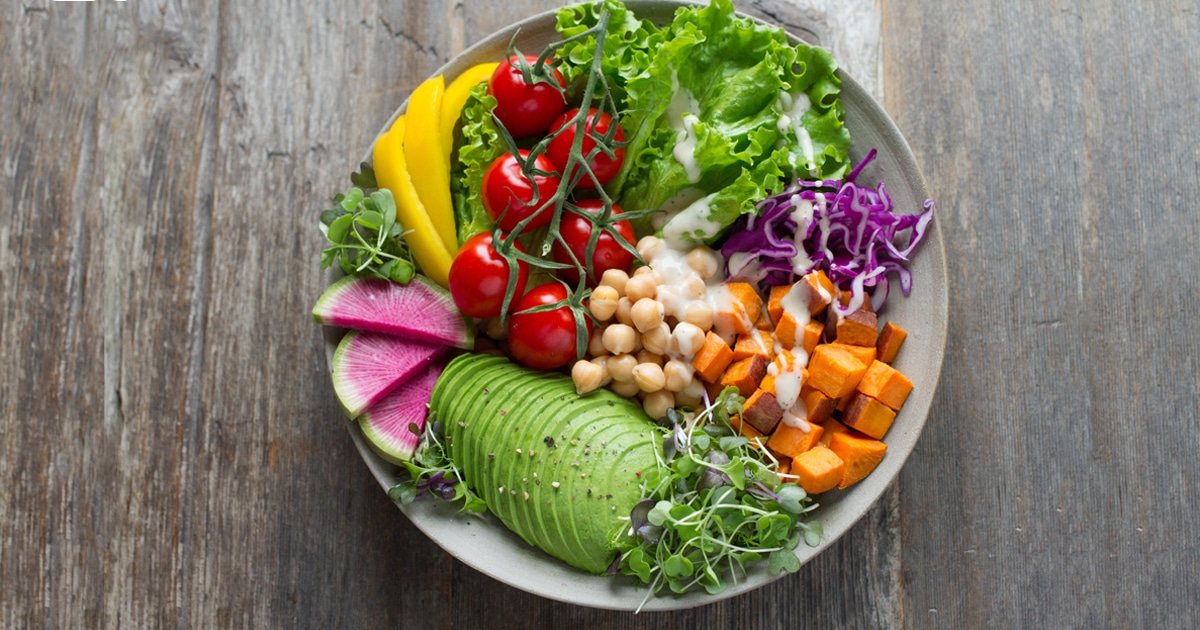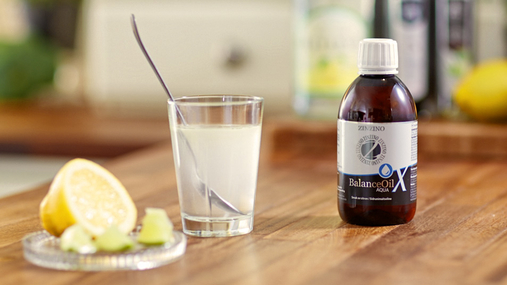
BALANCE OIL
Zinzino BalanceOil is a synergistic blend of high quality fish oil, rich in Omega-3 fatty acids EPA and DHA 4 , with specially selected extra virgin olive oil with a high content of polyphenols 5 .
BalanceOil safely regulates and maintains EPA and DHA levels and the balance between Omega-6 and Omega-3 fatty acids in your body.
BalanceOil supports normal brain function 1 and normal heart function, as well as normal immune system function. 3

- Normal brain function 1
- Normal heart function 2
- Normal functioning of the immune system 3
- Increases EPA and DHA levels in the body in a safe and effective way
- It helps regulate the Omega-6/Omega-3 balance to a normal ratio
- Increases polyphenol levels in your body to protect blood lipids from oxidative stress 6
- Supports normal eye function 7 , normal blood triglyceride levels 8 , normal blood pressure 9 , normal blood calcium levels 10 , normal bone structure 11 , muscle function 12 , dental health 13 and cellular division 14 .
A SYNERGIC FORMULA
BRAIN FUNCTION
EPA and DHA have approved health claims for maintaining normal brain function 1 . DHA contributes to the normal development of the brain of fetuses and breast-fed infants 1 . Long-chain Omega-3 fatty acids are important for us and for the next generation.
HEART FUNCTION
EPA and DHA have approved heart health claims. They contribute to the normal functioning of our heart 2 .
THE IMMUNE SYSTEM
BalanceOil contains vitamin D which is vital for the immune system as it contributes to its normal function 3 .
THE FISH OIL
The fish oils we use (from LYSI, Iceland) come mainly from short-lived pelagic fish such as sardines, anchovies and mackerel. The critical factor is a fatty acid profile that effectively optimizes the balance of Omega-6/3 fatty acids in the body within 120 days.
Our fish oil comes from whole, unprocessed fish. Fish oil undergoes a refining process to remove environmental contaminants. The fish oils used in Balance products have strict EPA and DHA specifications and are certified free of heavy metals and other toxins. LYSI, producer of BalanceOil, complies with all regulatory requirements in production and complies with the rules of good industrial practice and quality control (Good Manufacturing Practices, GMP) of food products and pharmaceutical preparations.
OLIVE OIL
BalanceOil contains an extra virgin cold-pressed olive oil specially selected for its high content of polyphenols (over 350mg/kg) 5 . Polyphenols are powerful antioxidants with numerous beneficial effects. They protect the BalanceOil inside the bottle and, just as importantly, inside your body. Our products are free of GMOs (i.e. Genetically Modified Organisms).
FISH OIL AND OLIVE OIL / SYNERGY = RESULTS
The modern processed food diet contains excessive amounts of Omega-6 fatty acids and insufficient Omega-3 fatty acids. Our scientists have formulated BalanceOil to combine Omega-3 fatty acids with the right amounts of polyphenols – a synergistic blend that delivers amazing results.
PROOF OF BALANCE WITHIN 120 DAYS
Our certified laboratories have analyzed more than 550,000 blood tests (October 2020), thus creating the largest database worldwide. The average Omega-6:3 balance for people not taking an Omega-3 dietary supplement is 12:1 for Northern Europe, 15:1 for Europe, and 25:1 for the US. After taking BalanceOil for 120 days, the average balance is less than 5:1 and in many cases under 3:1.
SUGGESTED USE : 0.15 ml BalanceOil x kilogram of body weight. Adjust the dose amount based on body weight. Adults with a body weight of 50 kg: 7.5 ml daily. Adults with a body weight of 80 kg: 12 ml daily. Do not exceed the recommended daily dose. Dietary supplements are not intended as substitutes for a varied and balanced diet.
STORAGE : Store the sealed bottle in a dark, dry place at room temperature or in the refrigerator. Store the opened bottle in the refrigerator and use the formulation within 45 days. At a temperature below 4° C the oil may become cloudy due to coagulation of the olive oil. The slide will return to room temperature. Keep away from children.
NOTICE: If you are taking anticoagulant medication, consult your doctor before using BalanceOil.
| Nutritional value | 7.5 ml | 12 ml |
| Fish oil | 4142 mg | 6627 mg |
| Omega-3 fatty acids | 1549 mg | 2478 mg |
| of which : C20:5 (EPA) | 802 mg | 1283 mg |
| of which: C22:6 (DHA) | 427 mg | 683 mg |
| Oleic Acid (Omega-9) | 1918 mg | 3069mg |
| Vitamin D3 | ||
| (250 % of the GDR)* | 12.6 ug | |
| (400 % of the RSA)* | 20 ug | |
| * % recommended daily intake (RDA) Directive 90/496/EEC | ||
Ingredients : Fish oils (from anchovies, mackerel, sardines), cold-pressed olive oil, mixed tocopherols (antioxidants), flavor*, Vitamin D3 (cholecalciferol). *Vanilla, lemon, orange-lemon-mint, grapefruit-lemon-lime
Frequent questions
What are Omega-3s? Omega-3 is a collective term that encompasses the group of long-chain polyunsaturated fatty acids in which the first double bond is between the third and fourth carbon atoms, counting from the methyl end. Omega-3 fatty acids are essential. This means that the body itself cannot produce these acids, so they must be obtained through the diet. The exception is women of reproductive age, who can produce Omega-3 fatty acids in small amounts. However, it is recommended that women in this group get Omega-3 fatty acids through diet. There are different kinds of Omega-3 fatty acids; the short-chain, found in the plant kingdom, and the long-chain, from marine sources. Long-chain Omega-3 fatty acids have the highest bioactive activity, especially eicosapentaenoic acid (EPA, Omega-3 C20:5) and docosahexaenoic acid (DHA, Omega-3 C22:6).
In what kind of foods can I find Omega-3? Long-chain Omega-3 fatty acids (EPA and DHA) are found mainly in fatty fish, such as sardines, mackerel, anchovies and salmon, while short-chain Omega-3 α-linolenic acid (ALA) is found in most vegetable oils.
Why Should I Take Omega-3 Dietary Supplements? Omega-3 fatty acids of marine origin are important for achieving the normal balance between components within your body. In addition, Omega-3 fatty acids are important for normal and healthy growth. A number of documented scientific studies show that Omega-3 (EPA and DHA) are important for the health of our cardiovascular system 2 , fetal development 1 , mental function, mood and behavior, etc.
How much Omega-3 do I need? The minimum recommended daily intake of EPA and DHA varies by country and organism. Below are some examples:
- European Food Safety Authority (EFSA): 250mg EPA and DHA/day
- American Heart Association: 2 servings of oily fish per week
- International Society for the Study of Fatty Acids and Lipids (ISSFAL): At least 500mg EPA + DHA / day
- World Health Organization (WHO): 200-500mg EPA + DHA / day
Our Western diet is characterized by an excess of Omega-6 compared to Omega-3 fatty acids, which makes it necessary to increase the intake of Omega-3 fatty acids up to 3g to achieve a normal Omega-6/Omega-3 fatty acid balance.
Where does the fish oil used to make BalanceOil come from? BalanceOil is produced by LYSI in Iceland. The fish oil used comes mainly from short-lived pelagic fish such as sardines, anchovies and mackerel. There is no specific fish requirement, so up to 30 different fish species can be used over time. A crucial factor is the fact that the fish oil has an optimal fatty acid profile (EPA + DHA) which will ensure an effective and optimal Omega-6 / Omega-3 balance within the body within 120 days.
Wild fish are caught from various places such as the Atlantic Ocean and the Pacific Ocean. The fish oil receives certification from local authorities, which states that it is caught in approved fishing zones, many of which are approved by the organization "Friend of the Sea". Our fish oil comes from whole and unprocessed fish, any leftovers are used as animal feed to reduce waste. The fish oil is analyzed and certified to comply with all European regulations for heavy metals, toxins and other pollutants.
At LYSI, the oil undergoes a further refining process to remove environmental contaminants before it is mixed with olive oil. LYSI complies with all regulatory requirements in the field of production and complies with the rules of good industrial practice and quality control (Good Manufacturing Practices, GMP) of food products and pharmaceutical preparations.
Is there genetically modified material in fish oil? No.
Why is it important to have a normal Omega-6/Omega-3 fatty acid balance? Our Western diet contains a lot of Omega-6 fatty acids and relatively small amounts of marine Omega-3 fatty acids, which increases the imbalance between Omega-6 and Omega-3 fatty acids in the body. This imbalance is a driving force for the emergence of lifestyle-related health problems. Both Omega-6 and Omega-3 fatty acids are precursors to signaling molecules (eicosanoids) in the body. Omega-6 derived eicosanoids are pro-inflammatory and support chronic inflammation. Signaling molecules derived from Omega-3 fatty acids have lower inflammatory potential, and some are anti-inflammatory. Eicosanoids complement each other in a variety of ways, and for this reason it is important to have a good balance between them. A normal Omega-6/Omega-3 fatty acid balance is fundamental to a good eicosanoid balance, while a high Omega-6/Omega-3 imbalance supports chronic inflammation. The Nordic Council of Ministers recommends that the balance of Omega-6/Omega-3 fatty acids in the diet be lower than 5:1.
How do I know if I have a normal balance of Omega-6 and Omega-3 fatty acids? We advise everyone to check the balance between Omega-6/Omega-3 fatty acids using the ZinzinoTest. The test measures fatty acids in the blood and reflects the profile of fatty acids in the daily diet. This profile calculates Omega-3 levels and the balance between Omega-6/Omega-3 fatty acids. If you are eating a balanced diet, the balance between Omega-6/Omega-3 fatty acids should be lower than 5:1, preferably lower than 3:1.
BALANCEOIL CLAIMS (EFSA)
1 DHA contributes to the maintenance of normal brain function. The claim may only be used for foods containing at least 40 mg DHA per 100 g and per 100 kcal. In order to use this claim, the information should be provided to the consumer that the beneficial effects are ensured with a daily intake of 250 mg of DHA. Maternal intake of docosahexaenoic acid (DHA) contributes to normal fetal and breast-fed infant brain development. The pregnant/nursing mother is informed that the positive results are ensured with a daily intake of 200 mg of DHA in addition to the recommended daily intake of ω-3 fatty acids for adults, namely: 250 mg of DHA and EPA. The claim can only be used for foods that provide a daily intake of at least 200 mg of DHA.
2 EPA and DHA contribute to the normal functioning of the heart. The claim may only be used for foods which are at least a source of EPA and DHA as referred to in the claim SOURCE OF OMEGA-3 FATTY ACIDS, as listed in the Annex to Regulation (EC) No. 1924/ 2006. In order to use this claim, the information should be provided to the consumer that the beneficial effects are ensured with a daily intake of 250 mg of EPA and DHA.
3 Vitamin D contributes to the normal functioning of the immune system. The claim may only be used for food which is at least a source of vitamin D as referred to in the claim SOURCE OF [NAME OF VITAMIN(S)] AND/OR [NAME OF INORGANIC SALT(S)], as listed in the annex to Regulation 1924/2006.
4 The claim that a food is high in omega-3 fatty acids, as well as any claim likely to have the same meaning for the consumer, may only be used when the product contains at least 0.6 g of linolenic acid per 100 g and per 100 kcal or at least 80 mg sum of eicosapentaenoic acid and docosahexaenoic acid per 100 g and per 100 kcal. It is analyzed and certified at the source.
5 The extra virgin olive oil used in BalanceOil comes from cold-pressed Picual olives and specially selected for its high content of polyphenols (over 350 mg/kg). It is analyzed and certified at the source.
6 Olive oil polyphenols contribute to the protection of blood lipids from oxidative stress. The claim may only be used for olive oil which contains at least 5 mg of hydroxytyrosol and its derivatives (eg complex of oleoeuropein and tyrosol) per 20 g of olive oil. In order to use this claim, the consumer should be provided with the information that the beneficial effects are ensured with a daily intake of 20 g of olive oil.
7 DHA contributes to the maintenance of normal vision. The claim may only be used for foods containing at least 40 mg DHA per 100 g and per 100 kcal. In order to use this claim, the information should be provided to the consumer that the beneficial effects are ensured with a daily intake of 250 mg of DHA. Intake of docosahexaenoic acid (DHA) contributes to normal vision development in infants up to 12 months of age. The consumer is informed that positive results are ensured with a daily intake of 100 mg of DHA. When the claim is used in infant formula, the formula contains DHA of at least 0.3% of total fatty acids.
8 DHA contributes to maintaining normal levels of triglycerides in the blood. The claim may only be used for foods that provide a daily intake of 2 g of DHA and that contain DHA in combination with eicosapentaenoic acid (EPA). In order to use this claim, the information should be provided to the consumer that the beneficial effects are ensured with a daily intake of 2 g of DHA. When the claim is used for dietary supplements and/or fortified foods, consumers should also be informed that they should not exceed a daily intake of 5 g of EPA and DHA combined.
9 DHA and EPA contribute to the maintenance of normal blood pressure. The claim can only be used for foods that provide a daily intake of 3 g of EPA and DHA. In order to use this claim, the information should be provided to the consumer that the beneficial effects are achieved with a daily intake of 3 g of EPA and DHA. When the claim is used for dietary supplements and/or fortified foods, consumers should also be informed that they should not exceed a daily intake of 5 g of EPA and DHA combined.
10 Vitamin D contributes to the normal absorption/utilization of calcium and phosphorus. The claim may only be used for food which is at least a source of vitamin D as referred to in the claim SOURCE OF [NAME OF VITAMIN(S)] AND/OR [NAME OF INORGANIC SALT(S)], as listed in the annex to Regulation 1924/2006.
11 Vitamin D contributes to maintaining the normal state of bones. The claim may only be used for food which is at least a source of vitamin D as referred to in the claim SOURCE OF [NAME OF VITAMIN(S)] AND/OR [NAME OF INORGANIC SALT(S)], as listed in the annex to Regulation 1924/2006.
12 Vitamin D contributes to the maintenance of normal muscle function. The claim may only be used for food which is at least a source of vitamin D as referred to in the claim SOURCE OF [NAME OF VITAMIN(S)] AND/OR [NAME OF INORGANIC SALT(S)], as listed in the annex to Regulation 1924/2006.
13 Vitamin D contributes to maintaining the normal condition of the teeth. The claim may only be used for food which is at least a source of vitamin D as referred to in the claim SOURCE OF [NAME OF VITAMIN(S)] AND/OR [NAME OF INORGANIC SALT(S)], as listed in the annex to Regulation 1924/2006.
14 Vitamin D plays a role in the process of cell division. The claim may only be used for food which is at least a source of vitamin D as referred to in the claim SOURCE OF [NAME OF VITAMIN(S)] AND/OR [NAME OF INORGANIC SALT(S)], as listed in the annex to Regulation 1924/2006.



